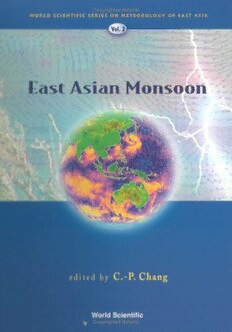
East Asian Monsoon (World Scientific Series on Meteorology of East Asia) PDF
576 Pages·2004·51.759 MB·English
Most books are stored in the elastic cloud where traffic is expensive. For this reason, we have a limit on daily download.
Preview East Asian Monsoon (World Scientific Series on Meteorology of East Asia)
Description:
The East Asian summer monsoon has complex space and time structures that are distinct from the South Asian summer monsoon. It covers both subtropics and midlatitudes and its rainfall tends to be concentrated in rain belts that stretch for many thousands of kilometers and affect China, Japan, Korea, and the surrounding areas. The circulation of the East Asian winter monsoon encompasses a large meridional domain with cold air outbreaks emanating from the Siberian high and penetrates deeply into the equatorial Maritime Continent region, where the center of maximum rainfall has long been recognized as a major planetary scale heat source that provides a significant amount of energy which drives the global circulation during boreal winter. The East Asian summer monsoon is also closely linked with the West Pacific summer monsoon. Both are part of the global climate system and are affected by El NinoBSouthern Oscillation (ENSO) and surface temperature variations in the western Pacific and surrounding oceans, the tropospheric biennial oscillation, and the South Asian summer monsoon. In addition, typhoons in the western North Pacific are most active during the East Asian summer monsoon. They may be considered as a component of the East Asian summer monsoon as they contribute substantial amounts of rainfall and have major impacts on the region. Because of its impacts on nearly one-third of the world's population and on the global climate system (including effects on the climate change), the study of the East Asian monsoon has received increased attention both in East Asian countries and in the United States. This book presents reviews of recent research on the subject.
See more
The list of books you might like
Most books are stored in the elastic cloud where traffic is expensive. For this reason, we have a limit on daily download.
